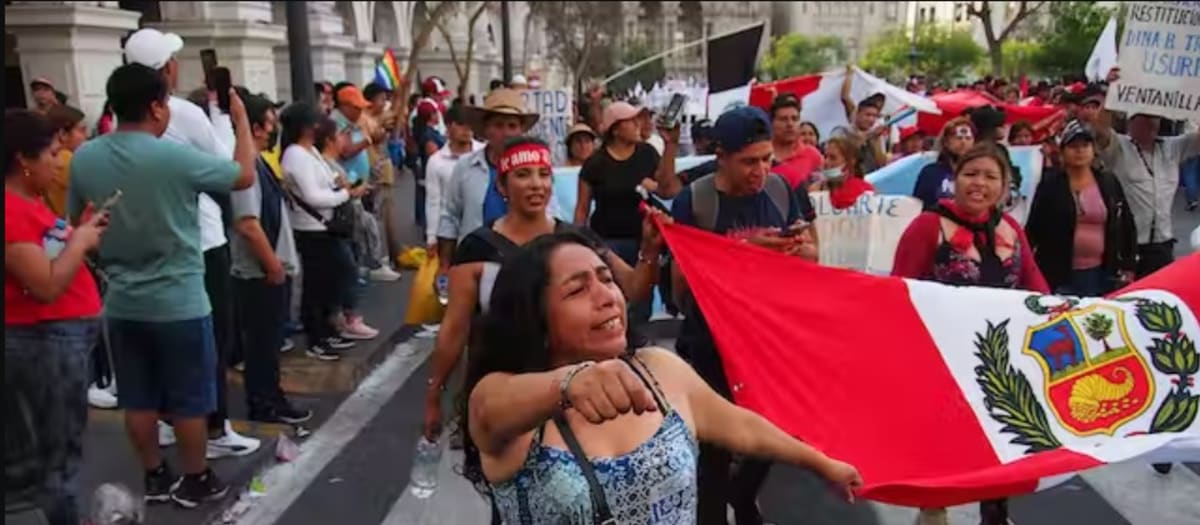Welcome to DU!
The truly grassroots left-of-center political community where regular people, not algorithms, drive the discussions and set the standards.
Join the community:
Create a free account
Support DU (and get rid of ads!):
Become a Star Member
Latest Breaking News
General Discussion
The DU Lounge
All Forums
Issue Forums
Culture Forums
Alliance Forums
Region Forums
Support Forums
Help & Search
Latin America
Related: About this forumPeru protests: What to know about Indigenous-led movement shaking the crisis-hit country

A movement on the march. Carlos Garcia Granthon/Fotoholica Press/LightRocket via Getty Images
This article is republished from The Conversation under a Creative Commons license. Written by Eduardo Gamarra, professor of politics and international relations at FIU. Peru protests: What to know about Indigenous-led movement shaking the crisis-hit country
Politics, Law & Society
By Contributing Writer
January 20, 2023 at 1:38pm
Eduardo Gamarra, Florida International University
Peru is in the midst of a political and civil crisis. Weeks of protest have culminated in thousands descending on the capital amid violent clashes and running battles with police.
Triggered by the recent removal from power of former leader Pedro Castillo, the protests have exposed deep divisions within the country and are being encouraged by a confluence of internal factors and external agitators.
The Conversation asked Eduardo Gamarra, an expert on Latin American politics at Florida International University, to explain the wider context of the protests and what could happen next.
What sparked the protests in Peru?
The immediate trigger was events on Dec. 7, 2022, that saw now-ousted President Castillo embark on what has been described as an attempted coup. But whether it was a “coup” is subject to debate. Castillo’s supporters say he was trying to head off a different type of coup, one instigated by Congress.
Castillo – a leftist, Indigenous former teacher from the country’s south – tried to shut down a Congress intent on impeaching him over corruption claims and accusations of treason. He called on the military to support him, and his intention was to form a constituent assembly to reform the country’s constitution. But his plan didn’t work. The military rejected Castillo’s ploy, and Congress refused to be dissolved and went ahead with its impeachment vote, removing him from power.
The events of that day set off the protests that have built in momentum over the subsequent weeks. But while the events of Dec. 7 were the immediate trigger, it is important to understand that this crisis was long in the making.
What is the wider background of the political crisis?
The crisis is rooted in the nature of Peru’s political system. In part by design, the country’s constitution, which was adopted in 1993 but amended a dozen times since, creates ambiguity in who has the greater power – the president or Congress. Constitutionally, Congress is given enormous scope to limit executive power, including removal through impeachment. The idea was to serve as a bulwark against the excesses of authoritarian-minded presidents. But in reality, it encourages instability and a weak executive. The constitution is so ambiguously written that it also gives wiggle room for presidents who want to shut down Congress, as Castillo unsuccessfully tried to do.
More:
https://news.fiu.edu/2023/peru-protests-what-to-know-about-indigenous-led-movement-shaking-the-crisis-hit-country
InfoView thread info, including edit history
TrashPut this thread in your Trash Can (My DU » Trash Can)
BookmarkAdd this thread to your Bookmarks (My DU » Bookmarks)
1 replies, 495 views
ShareGet links to this post and/or share on social media
AlertAlert this post for a rule violation
PowersThere are no powers you can use on this post
EditCannot edit other people's posts
ReplyReply to this post
EditCannot edit other people's posts
Rec (2)
ReplyReply to this post
1 replies
 = new reply since forum marked as read
Highlight:
NoneDon't highlight anything
5 newestHighlight 5 most recent replies
= new reply since forum marked as read
Highlight:
NoneDon't highlight anything
5 newestHighlight 5 most recent replies
Peru protests: What to know about Indigenous-led movement shaking the crisis-hit country (Original Post)
Judi Lynn
Jan 2023
OP
TexasTowelie
(112,070 posts)1. From Al Jazeera: